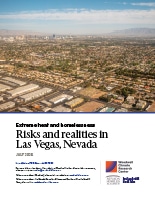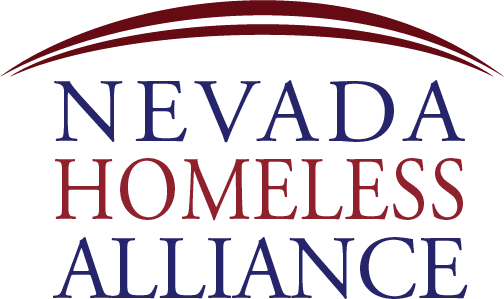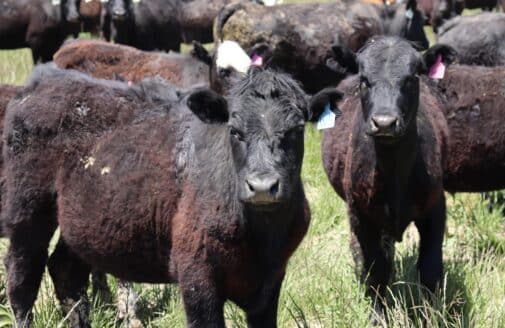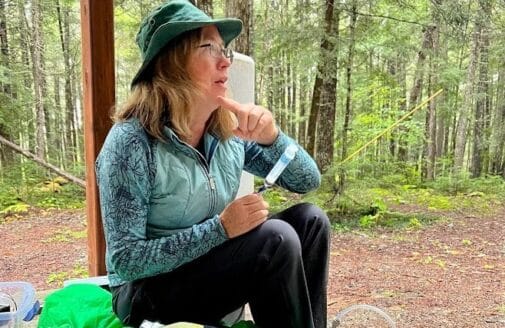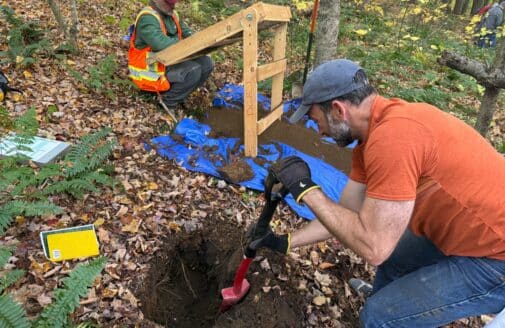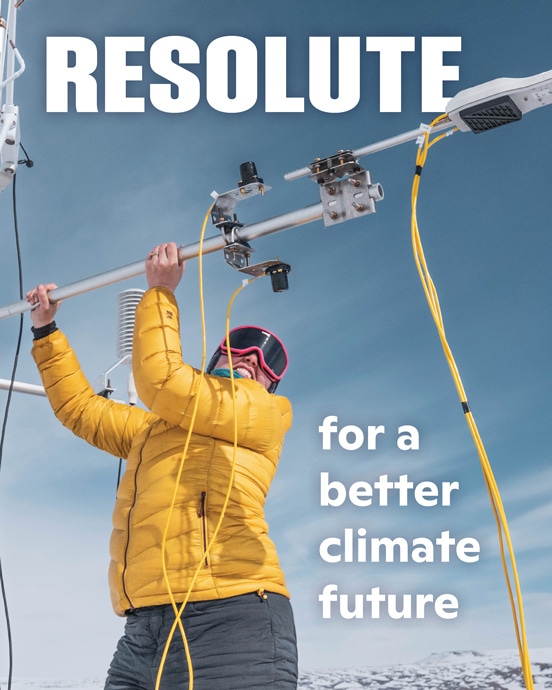Extreme heat and homelessness: Risks and realities in Las Vegas, Nevada
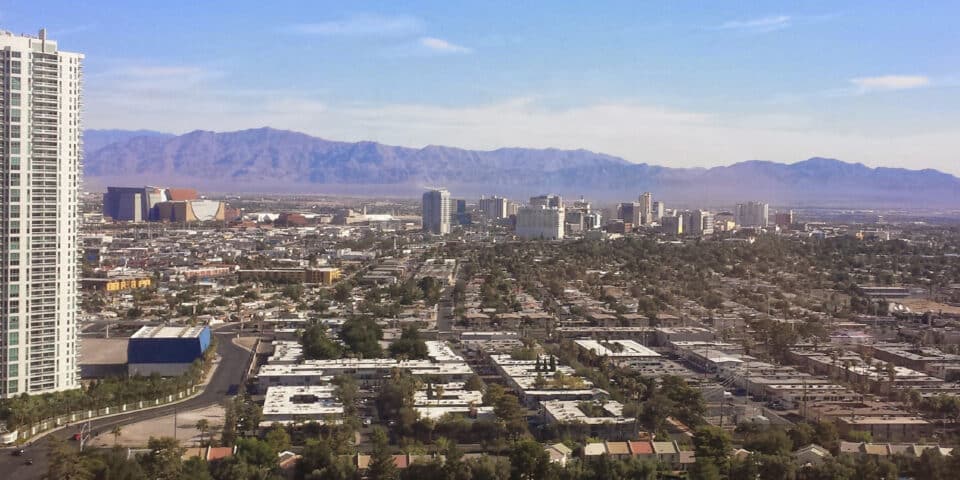
In collaboration with
Executive summary
- Homelessness and climate change are deeply connected in Las Vegas, where extreme heat and flooding are already causing fatalities among people experiencing homelessness. In 2024, 147 individuals who were experiencing homelessness passed away due to heat-associated causes, a 39% increase compared to the previous record-high of 106 losses in 2023.
- Currently, an estimated 7,468 people experiencing homelessness—some of whom may have been counted more than once—across 87 census tracts on the East Side of Las Vegas endure higher-than-average hot days (≥100°F) in the summer and throughout the year, increasing their risk of heat-related illness and mortality. Extreme heat has and will continue to disproportionately affect the East Side, where there are more communities of people experiencing homelessness.
- By 2030, all homeless shelters in Las Vegas will face 70–80 hot summer days (≥100°F), rising to nearly every summer day by 2080. Very hot summer days (≥110°F) are expected to increase from an average of nine to as many as 48–60 days by 2080 in the most affected areas. Most homeless shelters and an estimated 7,191 people experiencing homelessness today across 79 census tracts are already exposed to above-average hot nights (≥80°F), compounding the danger by preventing overnight relief from heat.
- Temperature conditions for excessive heat warnings are projected to occur twice as often by 2030 and seven times as often by 2080, requiring cooling stations to transition from occasional, daytime-only operations to near-continuous, 24-hour service throughout the extended summer season.
- Interim solutions like cooling stations, mobile cooling units, and shade structures are necessary for the immediate safety and health of people experiencing homelessness. However, the most effective solution to reduce extreme heat risk for people experiencing homelessness is to end homelessness through permanent supportive housing.
Introduction
Las Vegas, Nevada is known for its oppressively hot, dry climate with multiple weeks per year exceeding 100°F. It is the second-fastest warming city in the United States with an overall 5.9°F increase in annual average temperature from 1970 to 2024.¹ Over that time, the population in Clark County—which includes Las Vegas—grew 778%, reaching 2.4 million people today.² This population growth occurred alongside extensive urban sprawl in the Las Vegas Valley as desert landscapes were converted to separated residential, commercial, and recreational spaces that promote car-dependency. The spread of low-density neighborhoods, loss of natural vegetation, and increase in impervious surfaces such as buildings, roads, and parking lots have contributed to the urban heat island effect in the valley, leading to higher temperatures and creating significant disparities in heat exposure across neighborhoods. These same impervious surfaces also prevent rainfall from being absorbed into the ground, resulting in greater stormwater runoff and an increased risk of flooding. However, there is a pervasive, systemic socio-economic issue that is becoming increasingly connected to the climate crisis: homelessness.
Co-authored with Nevada Homeless Alliance and Southern Nevada Lived X Team, this report is the first of a two-part series that weaves together the lived realities of extreme heat and flooding among people who have experienced homelessness, and examines how these risks are projected to change in the future due to climate change.³ Nevada Homeless Alliance is a nonprofit organization dedicated to ending homelessness in Southern Nevada through advocacy at all levels of government, public and provider education, cross-sector coordination, and direct service. Working closely with Nevada Homeless Alliance, Southern Nevada Lived X Team is a group of individuals with lived experience of homelessness who serve as consultants, advocates, and advisors within the region’s homelessness response system. Their mission is to ensure that the perspectives of people who have experienced homelessness are meaningfully integrated into policies, strategies, and community initiatives.
This report examines different metrics of extreme heat, while the next installment will spotlight flooding. In this series, projections of climate risks are enriched with experiences and stories from Lived X members. These firsthand accounts bring to light the real and consequential impacts of climate change and extreme weather on people who have experienced, or are currently experiencing, homelessness. Throughout this report, we use the person-first language of “people experiencing homelessness” to emphasize people’s humanity and recognize homelessness as a temporary situation a person is experiencing, not their defining identity.
Homelessness in Las Vegas quote by Brian Begay, Lived X Member
“People think of Las Vegas as this glamorous place, but on the streets, it’s a different world. The city sparkles for tourists, but it scorches those who don’t have keys to a door. When you’re out there with nowhere to go, the sun becomes a predator. And all you can do is hope you can make it to tomorrow.”
Homelessness in Las Vegas
Across the United States, the Department of Housing and Urban Development quantifies homelessness using the Point-in-Time (PIT) Count. The PIT Count occurs over one day in January when teams of government employees, homeless service providers, and volunteers count and survey the number of people experiencing homelessness in each Continuum of Care (CoC) community. In 2024, the most recent Southern Nevada CoC PIT Count reported that 7,906 people were experiencing homelessness on a single night in Clark County.⁴ This represented a 20% increase, or 1,340 more people, compared to the previous year, continuing a recent trend of rising homelessness (Figure 1). Of those counted, 4,202 individuals, or approximately 53%, were experiencing unsheltered homelessness, meaning they were living on the street, in the desert, or in other places not suitable for human habitation.
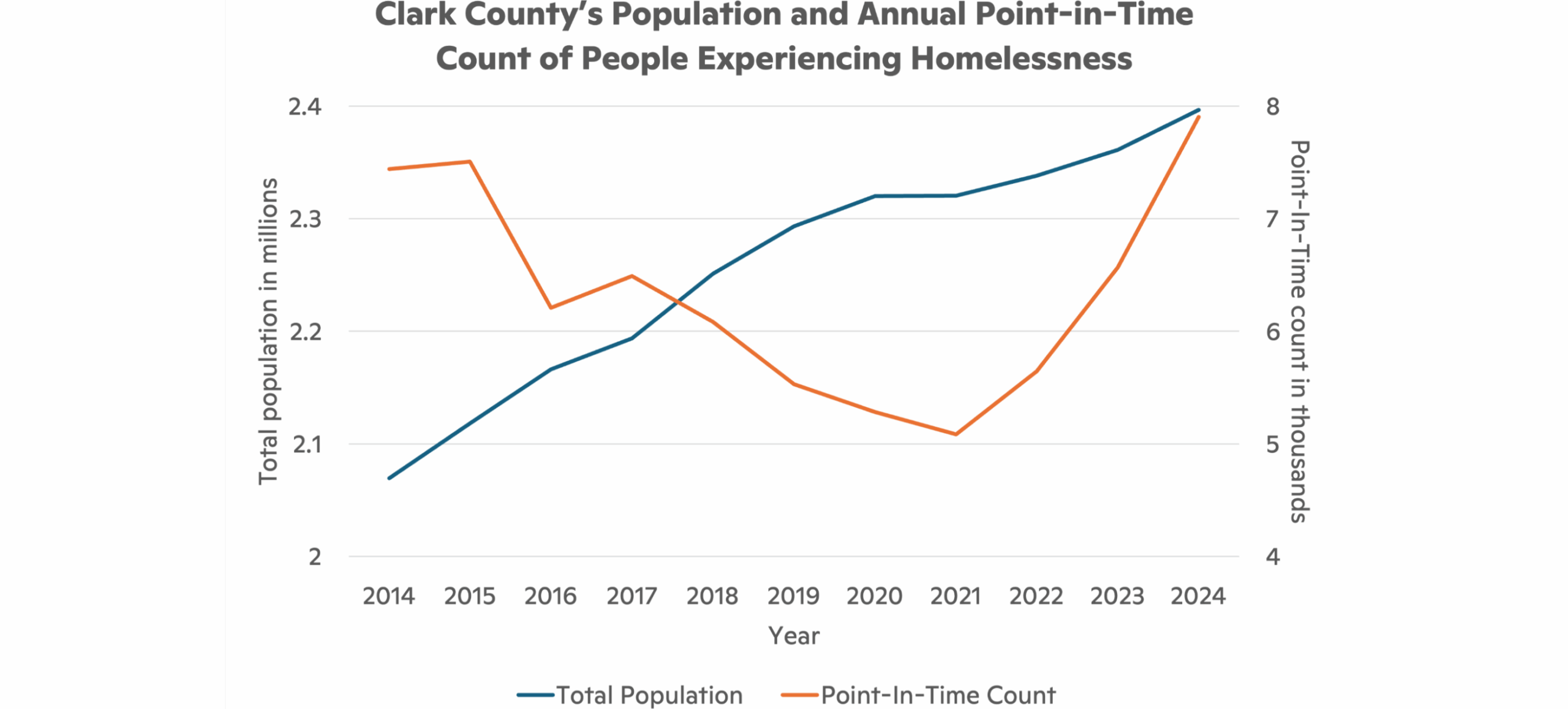
Figure 1: Total annual population (blue line graph) and number of people experiencing homelessness accounted for in the Point-In-Time Count (orange line graph) in Clark County from 2014 to 2024.
Throughout the year, several local social service agencies deploy Homeless Response Teams across Clark County to conduct interventions, abatements, and health and safety checks, encouraging people experiencing homelessness to connect with available services. One of these agencies is HELP of Southern Nevada, a local nonprofit and member of the Southern Nevada CoC.⁵ Over 12 months between January 2024 and April 2025, their direct outreach counted 9,189 individuals experiencing homelessness throughout the Las Vegas Valley, though some may have been counted more than once (Figure 2). Aggregating individuals’ point locations by census tract revealed that 90 out of 112 census tracts with high homelessness rates and densities are located on the East Side, defined broadly as the region east of the I-15. Four out of every five census tracts with high levels of homelessness face high social vulnerability according to The Centers for Disease Control and Prevention and Agency for Toxic Substances and Disease Registry (CDC/ATSDR) Social Vulnerability Index.⁶ This means these communities are more likely to experience negative impacts from disasters or public health emergencies due to factors such as high poverty rates, limited access to transportation, crowded or unstable housing, and higher proportions of Black, Native, Hispanic, Latino, and Asian populations. Mapping the geographic distribution of where people are experiencing homelessness is necessary to assess climate risk exposure. However, these data are subject to several limitations, including possible duplicate counts and undercounting due to the often transient and at times hidden nature of people experiencing homelessness.
Nomadic lifestyle excerpt by Martin Castro, Lived X Member
“Living on the streets of Southern Nevada for three years, there are countless times I had to rely on sleeping in bushes and similar measures to escape the heat. I wasn’t the type to build an encampment in one set location. I’m not even sure I knew how to do that, nor did I meet anyone that favored that lifestyle versus always being on the move. Being nomadic in a sense is what kept me going for survival, but that same walking lifestyle is what made me rely on drug use to keep me awake.”
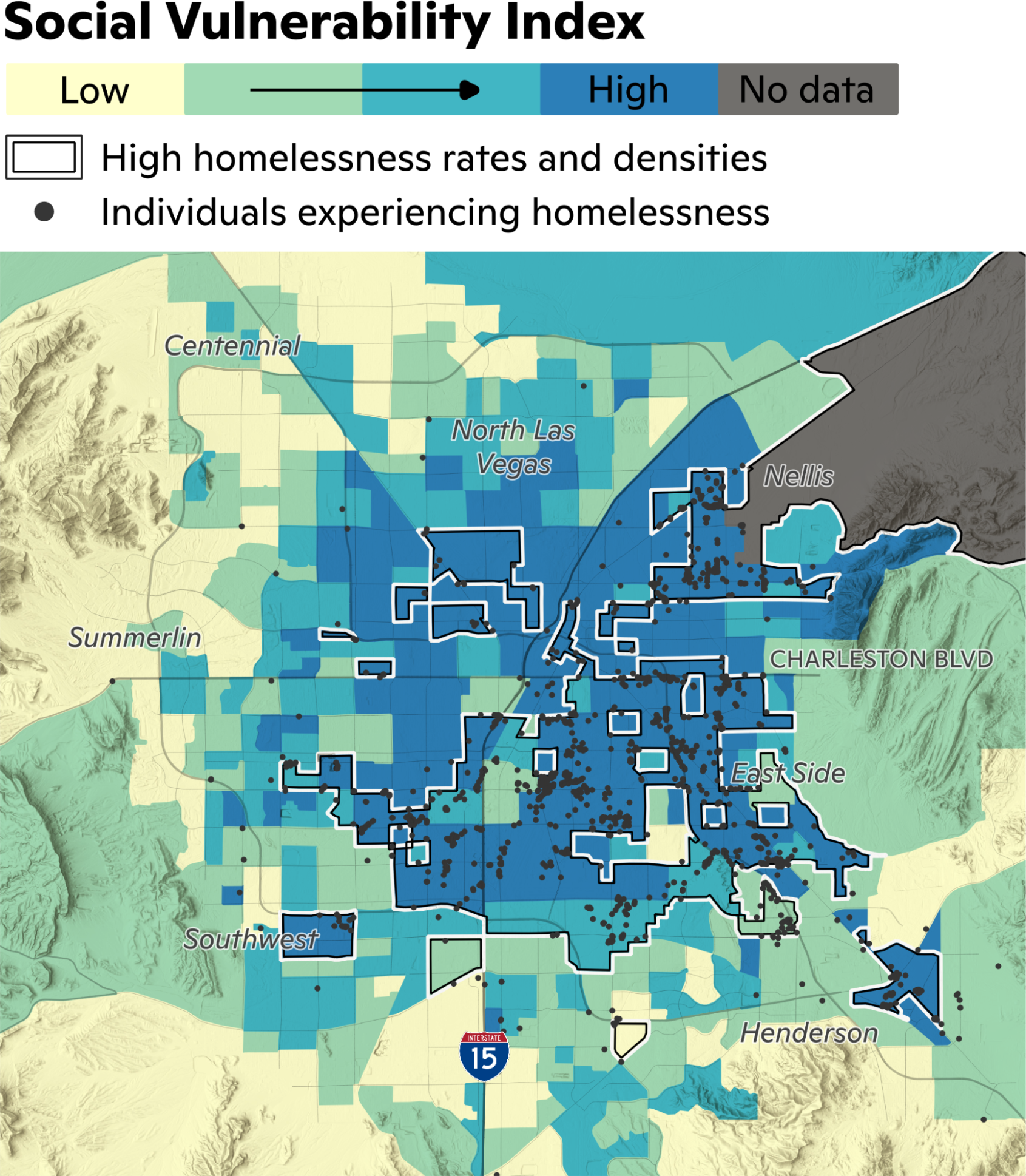
Figure 2: 2022 CDC/ATSDR Social Vulnerability Index, where high social vulnerability is shown in deep blue. Black dots show point locations of where HELP of Southern Nevada Homeless Response Teams interacted with individuals experiencing homelessness. Outlined in white, census tracts with high homelessness rates and densities were calculated from point locations. Neighboring census tracts with high levels of homelessness are combined into one area.
With limited options to shelter, people experiencing homelessness are at the forefront of environmental risks, especially during extreme weather events. In Las Vegas, people experiencing homelessness live both at street level and underground. Communities of people experiencing homelessness live inside stormwater infrastructure in washes, channels, and tunnels throughout the valley to escape the heat and have more private shelter. On average, Las Vegas receives 4.18 inches of annual precipitation, making stormwater infrastructure a dry, shaded refuge, particularly in the summer.⁷ Shifting precipitation patterns due to climate change are likely to affect the viability of these spaces as shelter.
Already, extreme weather and climate change are fatally impacting communities experiencing homelessness in Las Vegas. Underground communities are exposed to flooding risks, especially during monsoon season from late June to mid-September. At least four of the seven flood losses in Clark County over the past decade were individuals experiencing homelessness.⁸ In 2022, Las Vegas experienced its wettest monsoon season in over ten years, receiving 1.77 inches of rain and resulting in two flood losses inside tunnels (Figure 3). The following year’s monsoon season in 2023 became the ninth-wettest on record, receiving 2.88 inches of rain. One person whose housing status was unknown passed away due to flooding that year. Over the past ten years, the number of heat-associated losses has steadily increased, reaching an all-time high last summer in 2024.
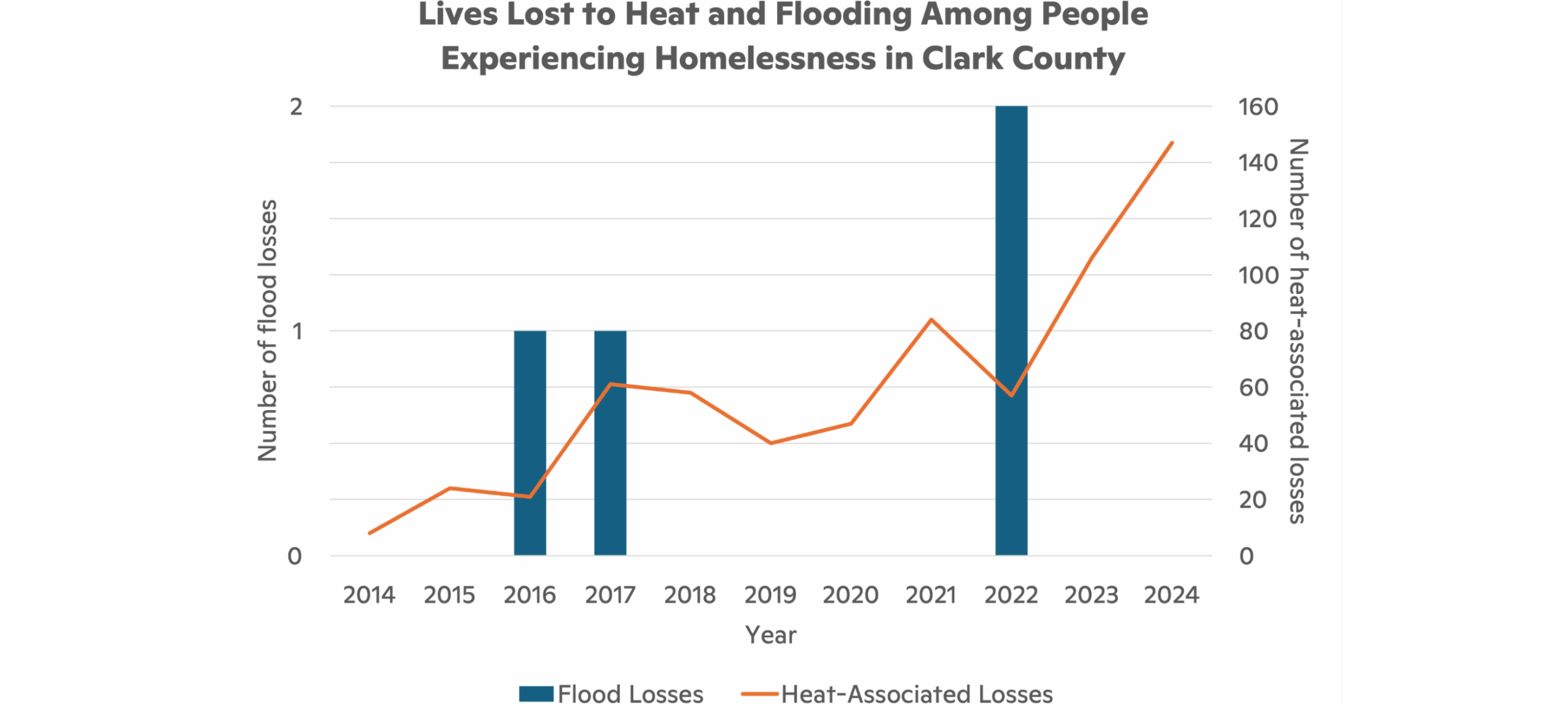
Figure 3: Number of heat-associated losses among people experiencing homelessness (orange line graph) and flood losses among people experiencing homelessness (blue bar graph) in Clark County from 2014 to 2024.
Loss of community member excerpt by Edwin Santiago-Colon, Lived X Member
“A few years ago, during one of the hottest summers in Las Vegas, a homeless man we knew passed away from heat stroke. He had been lying in his usual spot. At first, everyone assumed he was just sleeping, something not uncommon in the hot afternoons. No one thought to check. By the time someone realized something was wrong, it was too late.
The news spread quickly. We were devastated. The idea that he might’ve been suffering while we carried on with our day haunted many of us. We couldn’t help but wonder if things would’ve been different had we just noticed sooner—if someone had checked on him, offered water, or called for help. That kind of guilt doesn’t go away easily.
His death was a crucial reminder of how fragile life is when you live on the streets, and how easy it is for someone to be overlooked. His passing became a quiet lesson about awareness, compassion, and how important it is to truly see each other.”
The summer of 2024 broke several heat records for the Las Vegas Valley.⁹ The average summer temperature reached 96.2°F, surpassing the previous record of 93.7°F set in 2018. In July 2024, the all-time high temperature at Harry Reid International Airport was recorded at 120°F. The valley experienced seven consecutive days with a high temperature of 115°F or higher, 43 consecutive days of 105°F or higher, and 63 consecutive days with low temperatures of 80°F or higher. During this record-breaking year of extreme heat, 147 individuals who were experiencing homelessness passed away due to heat-associated causes, a 39% increase compared to the previous record-high of 106 losses in 2023 (Figure 3). These unprecedented temperatures underscore the escalating risks posed by extreme heat, highlighting the urgent need for targeted interventions to protect the region’s most vulnerable populations.
Summer 2024 excerpt by Ronnie Doak, Lived X Member
“It was a sweltering hot day, last year [2024] in July. I was at a Walgreens on Las Vegas Blvd [which runs along the I-15] and Charleston Blvd. The sky was clear, and the sun was like a fireball in the sky. I was browsing the candy section looking for a snack when a homeless woman toting a couple bags could barely talk or breathe. I watched as I saw her signal the cashier the universal sign of water, barely able to utter the words that she was gonna pass out. The cashier was very rude, as most of my experience as being homeless I’ve had similar encounters. She was told that if she couldn’t pay for the water she would have to leave because she was causing a commotion to the customers.
I immediately approached the woman and took out my phone to dial 911. As a prior first responder (fire-fighter), I recognized she was experiencing symptoms of heat stroke, dizziness, slurred, and jumbled words and cyanosis of the lips (blue in color). I purchased the water and laid her on the floor. I had assistance with some good samaritans to conceal her for privacy as I asked her to remove her shirt. Her core body temperature needed to be addressed and I poured water on her chest, neck, and head. They had her take small sips of water. I engaged her verbally to gauge her progress.
She expressed she had been walking for miles as she was homeless and had no place to go, new to Vegas, and didn’t know where to seek shelter. By then, paramedics arrived and were able to stabilize and transport the patient to the hospital for further evaluation.
The weather played so much of a factor as most people don’t know how important it is to stay hydrated. Even worse, the homeless continue to be harassed by the public if they try to sit down at buildings that offer shade. The stigma continues to affect the way we treat the disadvantage[d], which in my opinion is a stain on humanity. We should all strive to show compassion especially to the unsheltered in extreme heat conditions.
She almost died, but the truth is she didn’t have to, a small act of kindness can make all the difference. I continue to hope that one day the stigma of homelessness is addressed and that we continue to increase in love as ignorance dissipates. Las Vegas in the summer can kill the unsheltered. This is a fact, however, on this day humanity won the bout.”
Clark County has undertaken a comprehensive approach to address the growing threats of climate change through a series of strategic plans and initiatives. The All-In Clark County Community Sustainability and Climate Action Plan outlines the county’s commitment to reducing greenhouse gas emissions, building resilience to climate hazards, and prioritizing the health and safety of its residents. Additionally, the Regional Transportation Commission (RTC) of Southern Nevada’s Extreme Heat Vulnerability Analysis used a multidimensional framework informed by community input to identify and map present extreme heat vulnerability across the valley. Here we present the first local climate risk assessment on present and future extreme heat risks for people experiencing homelessness in partnership with Nevada Homeless Alliance and Southern Nevada Lived X Team.




